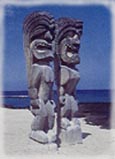A timeline of settlement
While dates constantly change with new archaeological discoveries, the general sequence for the settlement of Polynesia is pretty clear. (Dates represent earliest archaeological finds; they almost certainly do not represent the earliest presence of human beings.)
The time that people settled Polynesia
![]() --
50,000 years ago - Hunters and gatherers lived in Australia and New
Guinea
--
50,000 years ago - Hunters and gatherers lived in Australia and New
Guinea
![]() --
Around 1600-1200 B.C., people spread from New Guinea in Melanesia as
far east as Fiji, Samoa, and Tonga. Polynesian culture developed at
the eastern edge of this region (in Samoa and Tonga).
--
Around 1600-1200 B.C., people spread from New Guinea in Melanesia as
far east as Fiji, Samoa, and Tonga. Polynesian culture developed at
the eastern edge of this region (in Samoa and Tonga).
![]() --
Around 300 B.C. or earlier, seafarers from Samoa and Tonga discovered
and settled islands to the east - the Cook Islands, Tahiti, Tuamotus,
and Hiva (Marquesas Islands).
--
Around 300 B.C. or earlier, seafarers from Samoa and Tonga discovered
and settled islands to the east - the Cook Islands, Tahiti, Tuamotus,
and Hiva (Marquesas Islands).
![]() --Around
300 A.D. or earlier, voyagers from central or eastern Polynesia,
possibly from Hiva, discovered and settled Easter Island.
--Around
300 A.D. or earlier, voyagers from central or eastern Polynesia,
possibly from Hiva, discovered and settled Easter Island.
![]() --Around
400 A.D. or earlier, voyagers from the the Cook Islands, Tahiti, and
/or Hiva settled Hawai'i.
--Around
400 A.D. or earlier, voyagers from the the Cook Islands, Tahiti, and
/or Hiva settled Hawai'i.
![]() --Around
1000 A.D. or earlier, voyagers from the Society and/or the Cook
Islands settled Aotearoa (New Zealand).
--Around
1000 A.D. or earlier, voyagers from the Society and/or the Cook
Islands settled Aotearoa (New Zealand).
When European explorers found the islands of Polynesia, the common ancestry of the Polynesians was evident. The people from widely separated islands looked alike, spoke languages that were very much the same, and had similar cultural practices. The tools that they made, such as fish hooks, adzes, and ornaments, also looked similar. And they had the same basic stock of domesticated plants and animals.
Archaeologists have dug up remains of settlements, finding tools, discarded shells from eating shellfish, and other rubbish, and they have dated these. This gives an idea of how long ago an island had people living there.
|
A Fijian pendant of whale tooth |

Hawaiian carvings |
|
Melanesian splash board |
Club from the Marquesas Islands |